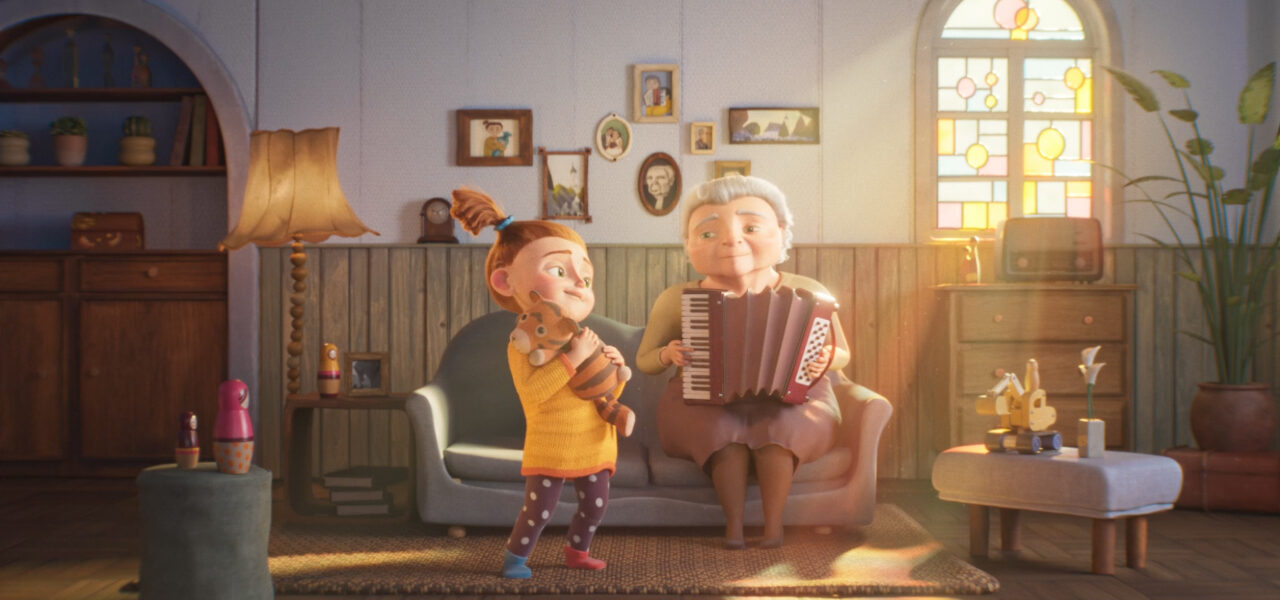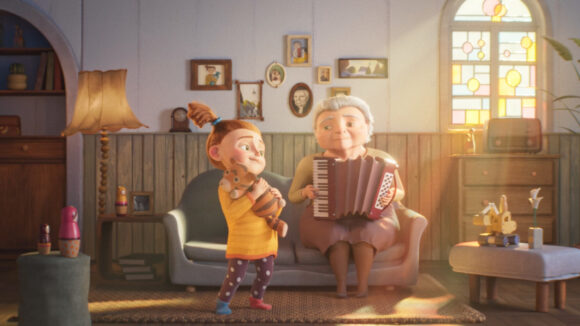

Why CG Animation Was The Right Choice For Damaris Zielke’s Approach To A Taboo Topic In ‘The Most Boring Granny In The Whole World’
The Most Boring Granny in the Whole World is a short that deals not only profoundly and sensitively with dying, but also proves what can come from training in an environment of cooperation and industry expertise.
In the winter of life, one becomes preoccupied with loss, grief, and remembering lost companions. Whereas a child, just setting out in life and full of bursting with curiosity, can hardly comprehend such topics. That generational clash makes the cg animated short The Most Boring Granny in the Whole World especially touching and heart-warming.
In this profound but humorous film, little Greta finds her grandma boring because she only has dull hobbies, such as looking at keepsakes and photos of the deceased, things Greta is not even allowed to play with. When her granny falls asleep on the sofa, the young girl starts to play at a pretend funeral with her. What happens next helps young Greta discover some essential questions about life.
The Most Boring Granny in the Whole World premiered at Berlinale 2022 and has since enchanted audiences at numerous festivals. It has already won prizes in Germany – a Golden Sparrow, and the ITFS Tricks for Kids award. At the Chicago International Children’s Film Festival it was awarded second place by the jury in the animated short film category. With its splendid cg look, it also qualified for competition at the Computer Animation Festival of SIGGRAPH Asia 2022.
The film is a student project made at the Filmakademie Baden-Württemberg. Director Damaris Zielke studied animation directing at the film school’s Animationsinstitut, one of Europe’s leading educational institutions for animation, visual effects, technical directing, animation/effects producing, and interactive media.
“The thought of making death a subject in a film probably has to do with the fact that my mom and my sister are nurses,” Damaris says of her graduation project. “My mother worked in Paderborn in the palliative care ward. She took us with her sometimes as children. So, I had early contact with the sick and elderly.”
At the ward, an art therapist once told Damaris that in the old days dying was different. People used to die at home with their family around, but nowadays it’s much more common to die at the hospital. The therapist even remembered a time when a relative’s corpse was laid out at her family’s place while she and other kids ran around it playing catch. This image stuck in Damaris’ head.
“It struck me that the experience of death can be something quite normal for kids,” Damaris explains. “In contrast to today’s society, where you keep them away from it as death is hardly a part of our everyday life, which makes it even scarier.”
The idea to take on this subject artistically came when she watched The Little Boy and the Beast at the Stuttgart Trickfilm International Animated Film Festival. “It’s a short about divorce, and I found it great how its perspective through the eyes of a child managed to approach such a complicated topic. That’s what I wanted to do too,” Damaris remembers.
At the time, she was studying communication design at Bauhaus University where she experimented with cut-out animation. But, she didn’t think her professional skills had her quite “ready to make an animated film about the topic.” So, she enrolled in the Filmakademie Baden-Württemberg to learn the skills needed to make it happen. “I wanted to learn more about storytelling and especially 3d animation, a field in which Animationsinstitut has a high level of competence.”
While enrolled there, she worked on The Most Boring Granny in the Whole World for around three years, starting by developing the script with screenplay student Manuel Ostwald. Her partnership with Ostwald was far from the last, however, as the Filmakademie and its Animationsinstitut put a heavy emphasis on collaboration. In their third year, students of all fields form production teams and work collaboratively on media projects while also being mentored and trained by professionals.
“Such an elaborate 3d animation project would not be possible without teamwork,” Damaris emphasizes. “I am very grateful for having had highly skilled teammates that brought the film to life with me.” All in all, about 30 students worked on the short. The core team from the Animationsinstitut consisted of Verena Nomura, who took on the Asset lead; technical director Jannick Otterbach, animation/effects producing student Jiayan Chen, Charlotte Hintzmann (concept art), Laura Staab (character design), and Denise Hoffmann (rigging).
Beyond Zielke’s Animationsinstitut classmates involved on the project, students from other Filmakademie fields of studies also played an important role. “With camera student Michael Throne we had a DOP on the team whose live-action expertise took the film’s cg to another level. And production design student Anna Vehres built a miniature set which helped us to create the film’s haptic look,” explains the director.
Looking back at her studies at the Animationsinstitut, Damaris is especially appreciative of the benefits of the personal network of industry professionals its students are put in contact with, as well as the state-of-the-art technological infrastructure to which every student has access. “All the connections the Animationsinstitut has built up over the years as a figurehead in the animation world is surely one reason why such successful projects are made there.”
Damaris recalls how much help Thomas Grummt, who worked as a lead animator for Dreamworks Animation and now teaches at the Animationsinstitut, was on her film. “He agreed to supervise the project. That was very cool. We met once a week remotely. With his big studio expertise, Thomas gave us feedback on all our steps from the U.S. That made our learning curve incredibly large.”
Another valuable influence was screenwriter Marcus Sauermann, author of the short The Little Boy and the Beast. He also gives lectures at the school regularly and became one of the crew’s mentors during the writing of the short.
This direct contact with industry professionals increases the chances of Animationsinstitut students getting high-profile jobs after their graduation. Damaris went on to work in the vfx industry in London after she finished her studies in 2021. “It was a great experience to work for Framestore and MPC. But I recently moved back to the Stuttgart Area, where the Filmakademie is located, and have just started to work for Studio Soi in Ludwigsburg.”
At Soi, she is now animating for the German children’s film Pumuckl and is pursuing new directing projects. “I have some ideas in mind, but let’s see. You need to be lucky to make a film.” She also emphasizes that in the Stuttgart area, the vfx and animation scenes are evolving more and more over time, and many opportunities for artists and directors can be found there.
Filmakademie Baden-Württemberg offers programs in animation, visual effects, technical directing, animation/effects producing, and interactive media. To learn more about attending one of these programs, visit the school’s website.

